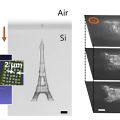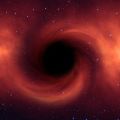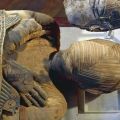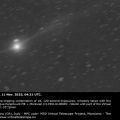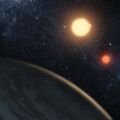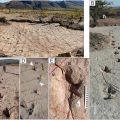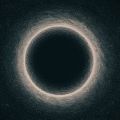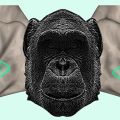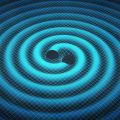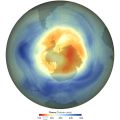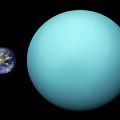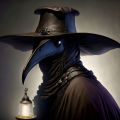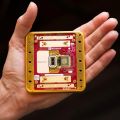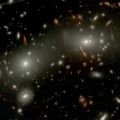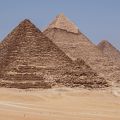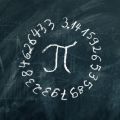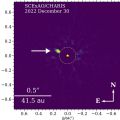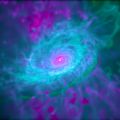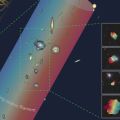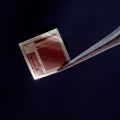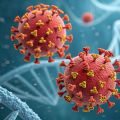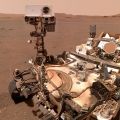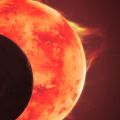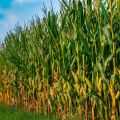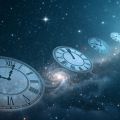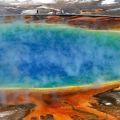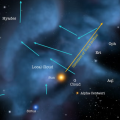Bibliographie sur l'histoire de la zoologie et de la botanique - Définition
La liste des auteurs de cet article est disponible ici.
Zoologie
Ouvrages généraux
- (en) J.H.R Andrews (1988). The Southern Ark: Zoological Discovery in New Zealand, 1769-1900, University of Hawaii Press : 238 p.
- (fr) Julius Victor Carus (1880). Histoire de la zoologie depuis l’Antiquité jusqu’au XIXe siècle. Baillière (Paris) : viii + 623 p. (texte disponible sur le site de la bibliothèque numérique gallica.
- (fr) Paul Delaunay (1997). La Zoologie au XVIe siècle, Hermann (Paris), collection Histoire de la pensée : xi + 338 p.
- (fr) Ferdinand Hoefer (1873). Histoire de la zoologie : depuis les temps les plus reculés jusqu’à nos jours. Hachette (Paris) : 412 p.
- (fr) Jean-Loup d’Hondt (2007). Histoire de la zoologie, Ellipses édition marketing S.A., collection L’esprit des sciences : 126 p.
- (fr) Jean Leclercq (1959). Perspectives de la zoologie Européenne : Histoire, problèmes contemporains, Duculot (Paris) : 163 p.
- (en) Willy Ley (1968). Dawn of zoology, Prentice-Hall, collection Prentice-Hall Series in Nature and Natural History : viii + 280 p.
- (en) Richard V. Melville (1995). Towards stability in the names of animals : A history of the International Commission on Zoological Nomenclature 1895-1995, International Trust for Zoological Nomenclature (Londres) : viii + 92 p.
- (fr) Georges Petit & Jean Théodoridès (1962). Histoire de la zoologie des origines à Linné. Hermann (Paris), coll. Histoire de la pensée : xi + 360 p.
Relations avec les animaux
- (fr) Jacques Boudet et Robert Laffont (1962). L'homme et l'animal : Cent mille ans de vie commune. Éditions du Pont Royal (Paris) : 295 p.
- (fr) Robert Delort (1984). Les Animaux ont une histoire, Seuil (Paris), collection L’univers historique : 399 p.
- (fr) Alfred Franklin, La vie privée d'autrefois : Arts et métiers, modes, moeurs, usages des Parisiens du XIIe au XVIIIe siècle d'après des documents originaux ou inédits, Librairie Plon (Paris).
- Série I, Vol.4 (1897) : Les Animaux aux Treizième et Quatorzième siècles ; xi + 336 p.
- Série I, Vol.5 (1899) : Les Animaux du Quinzième au Dix-neuvième siècle ; xix + 307 p.
- (en) Linda Kalof (2007). Looking at Animals in Human History, University of Chicago Press (Chicago) : 240 p.
- (fr) Pierre Loevenbruck (1955). Les animaux sauvages dans l’histoire, Payot (Paris), collection Bibliothèque historique : 208 p.
Mammalogie
- (en) Elmer C. Birney et Jerry R. Choate (1994). Seventy-five Years of Mammalogy (1919-1994), American Society of Mammalogists (Provo) : xiv + 433 p.
- (fr) Pierre Cabard et Bernard Chauvet (1998). L’Étymologie des noms de mammifères, Éveil Nature (Saint-Yrieix-sur-Charente), collection Éveil nature : 240 p.
- (en) Keir B. Sterling (dir.) (1987). An International History of Mammalogy. Volume One. Eastern Europe and Fennoscandia, One World Press (Bel Air, Maryland) : xxiv + 198 p.
- Les deux volumes suivants de cette série sont annoncés depuis plusieurs années.
Ornithologie
En français : Monographie récente : Chansigaud (2007). Le seul autre ouvrage disponible (Bouvier, 1925) est difficile à trouver et date de 80 ans. Par ailleurs, l'ouvrage de Cabard et Chauvet (2003) qui fait le point sur l'étymologie des noms d'oiseaux présente aussi une série de notices biographiques qui, même si elles ne constituent pas une histoire de la discipline, permettre d'en découvrir certains de ses aspects.
En anglais : le choix est plus vaste. Walters (2003) offre une bonne présentation de l'histoire de l'ornithologie (voir aussi Stresemann, 1975). Il faut aussi citer une intéressante étude de l'ornithologie comme science (Farber, 1996). Mearns et Mearns (1998) offre un angle très original en analysant le rôle et la place de la collection chez les ornithologues. Il existe aussi plusieurs livres d'étymologie semblable à l'ouvrage de Cabard et Chauvet cités plus haut comme Gruson (1972), Beolens et Watkins (2003), Mearns et Mearns (1988), ces deux derniers ouvrages étant plus historiques que le premier. Enfin, ces livres peuvent être complétés par des ouvrages sur l'histoire de l'ornithologie américaine (Barrow, 1998, Davis et Jackson, 1995, Kastner, 1986, Gibbons et Deborah, 1972).
Ouvrages généraux
- (fr)Maurice Boubier (1925). L’Évolution de l’ornithologie. Librairie Félix Alcan (Paris), coll. Nouvelle collection scientifique : ii + 308 p.
- (fr) Valérie Chansigaud (2007). L’Histoire de l’ornithologie, Les références du naturaliste, delachaux et Niestlé (Paris) : 239 p.
- (en) Paul Lawrence Farber (1996). Discovering birds : the emergence of ornithology as a scientific discipline, 1760-1850 [Second edition]. Johns Hopkins University Press (Baltimore), coll. Studies in the history of modern science 12 : xxiii + 191 p.
- (en) Barbara Mearns & Richard Mearns (1998). The Bird Collectors. Academic Press (Londres) : xvii + 472 p.
- (en) Erwin Stresemann (1975). Ornithology, from Aristotle to the present. Harvard University Press : xii + 432 p.
- (en) Michael Walters (2003). A Concise History of Ornithology. Yale University Press (New Haven, Connecticut) : 255 p.
Biographies d'ornithologues
- (en) Bo Beolens & Michael Watkins (2003). Whose Bird ? Common Bird Names and the people They Commemorate. Yale University Press (New Haven, Connecticut) : 400 p.
- (fr) Pierre Cabard & Bernard Chauvet (2003). L’Étymologie des noms d’oiseaux. Belin (Paris), coll. Éveil nature : 590 p.
- (en) Carrol L. Henderson (2007). Oology and Ralph's talking eggs : bird conservation comes out of its shell, University of Texas Press : 200 p.
- (en) Barbara Mearns & Richard Mearns (1988). Biographies for Birdwatchers: The Lives of Those Commemorated in Western Palearctic Bird Names. Academic Press (Londres) : 490 p.
- Présente environ quatre-vingt notices biographiques accompagnées de nombreuses notices biographiques.
- (en) Barbara Mearns et Richard Mearns (1992). Audubon to Xantus. The Lives of Those Commemorated in North American Bird Names, Academic Press (Londres) : xix + 588 p.
Histoires nationales
- (en) Marianne Gosztonyi Ainley (1986). From natural history to avian biology: Canadian ornithology, 1860-1950. Dissertation Abstracts International, 18.
- (en) Mark V. Barrow (1998). A Passion for Birds. American Ornithology after Audubon. Princeton University Press (Princeton, New Jersey) : x + 326 p.
- (en) Peter Bircham (2007). A History of Ornithology. A Survey of British Natural History, Collins (Londres), collection The New Naturalist Library : xii + 482 p.
- (en) Andrew Clements Cole (2006). The egg dealers of Great Britain : profiles of some catalogue dealers of the 19th and 20th centuries., Peregrine Books (Horsforth, Leeds) : 198 p.
- (en) William E. Jr. Davis & Jerome A. Jackson (1995). Contributions to the history of North American ornithology. Arno (New York), coll. Memoirs of the Nuttall Ornithological Club : vii + 501 p.
- (en) Felton Gibbons & Deborah Strom (1972). Neighboors to the Birds. A History of Birdwatching in America. Norton (New York) : 364 p.
- (en) Edward S. Gruson (1972). Words for Birds. A Lexicon of North American Birds with Biographical Notes. Quadrangle Books (New York) : xiv + 305 p.
- (en) Joseph Kastner (1986). A World of Watchers. An informal history of the american passion for birds. Sierra Club Books (San Francisco) : x + 241 p.
- (en) David Snow (1992). Birds, discovery and conservation : 100 years of the “Bulletin of the British Ornithlogists’ Club”, Helm Information (Mountfield) : ix + 198 p.
- (en) Keir B. Sterling (1974). Contributions to the history of American ornithology. Arno (New York).
Herpétologie
- (en) Kraig Adler (1989). Contributions to the History of Herpetology, Society for the study of amphibians and reptiles : 202 p.
- (fr) Jean Lescure et Bernard Le Garff (2006). L’Étymologie des noms d’amphibiens et de reptiles, Belin (Paris), collection Éveil nature : 207 p.
Ichtyologie
Il n'existe pas d'ouvrage général sur l'histoire de l'ichtyologie. Il faut noter cependant deux ouvrages en langue anglaise très riches. Le premier est la traduction en anglais d'un texte de Georges Cuvier, le second rassemble des articles sur la constitution des collections ichtyologiques à travers le monde. Une partie importante d'entre eux est consacrée à l'ichtyologie américain, un seul sur les collections françaises.
Ouvrages de base
- (en) Theodore W. Pietsch (1995). Historical portrait of the progress of ichthyology, from its origins to our own time by Georges Cuvier, Johns Hopkins University Press (Baltimore) : xxiv + 366 p.
- (en) Theodore W. Pietsch et William D. Anderson (dir.) (1997). Collection building in ichthyology and herpetology, Special publication, number 3, American Society of Ichthyologists and Herpetologists : xiii + 593 p.
Entomologie
En français : quelques ouvrages sont disponibles qui permettent de découvrir, plus ou moins complètement cette discipline. Mais ces livres privilégient exclusivement l'entomologie française au détriment d'une vision plus internationale.
En anglais : le choix est immense et abondant. Smith et al. (1973) constitue un ouvrage de référence. Certains livres permettent de découvrir l'organisation de l'entomologie aux États-Unis comme Weber (1930) qui décrit la naissance du département entomologique du ministère américain de l'Agriculture. De nombreuses autobiographies permettent d'en savoir plus sur la vie d'un entomologiste : Usinger (1972). Evans (1985) opte pour une histoire particulière : il traite des principales espèces d'insectes nuisibles aux États-Unis et décrit les étapes de la lutte contre elles.
Ouvrages de base
- (fr) Jacques d’Aguilar (2006). Histoire de l’entomologie, Delachaux et Niestlé (Lausanne), collection Les références du naturaliste : 224 p.
- (en) Edward Oliver Essig (1931). A History of Entomology. Mac Millan (New York) : vii + 1029 p.
- (en) Herbert Osborn (1937). Fragments of entomology history, including some personal recollections of men and events. vii + 394 p.
- (en) Herbert Osborn (1952). A brief history of entomology, including time of Demosthenes and Aristotle to modern times ; with over 500 portraits. Spahr & Glenn (Columbus, Ohio) : 303 p.
- (en) Ray F. Smith, Thomas E. Mittler et Carroll N. Smith (1973). History of Entomology, Annual Review Inc. (Palo Alto) : viii + 517 p.
Entomologie française
- (fr) Jean Gouillard (2004). Histoire des entomologistes français, 1750-1950. Édition entièrement revue et augmentée, Boubée (Paris) : 287 p.
- (fr) Jean Lhoste (1987). Les Entomologistes français. 1750-1950. INRA Éditions : 351 p.
Histoire nationale
- (en) Io Chou (1990). A History of Chinese Entomology, Tianze Eldonejo (Xian, Shaanxi, China) : 245 p.
- (en) Emory C. Cushing (1957). History of entomology in World War II. Smithsonian Institution Press (Washington) : vi + 117 p.
- (en) Arnold Mallis (1971). American Entomologists. Rutgers University Press (New Brunswick) : , : xvii + 549 p.
- (en) Paul W. Riegert (1980). From arsenic to DDT. A history of entomology in western Canada. University Toronto Press (Toronto) : xii + 357 p.
Entomologie appliquée
- (en) Howard Evans Evans (1985). The Pleasures of Entomology. Portraits of Insects and the People Who Study Them. Smithsonian Institution Press (Washington) : 238 p.
- (en) Leland Ossian Howard (1930). A History of Applied Entomology. Smithsonian Parks (USA) : Smithson. Misc. Coll., 84 : viii + 564 p.
- (en) Charles Lester Marlatt (1953). An Entomologist's Quest. The Sorty of the San Jose scale. Compte d’auteur : xi + 338 p.
- (en) William Dwight Pierce (1974). The deadly triangle : a brief history of medical and sanitary entomology. Natural History Museum of Los Angeles County (Los Angeles, Californie) : 138 p.
- (en) Gustavus Adolphus Weber (1930). The Bureau of Entomology: Its History, Activities and Organization. Brookings Institution (USA) : xii + 177 p.
Organisations entomologiques
- (en) Sheffield Airey Neave & Francis J. Griffin (1933). The history of the Entomological Society of London, 1833-1933. Royal Entomological Society (Londres) : ,xlvi + 244 p.
- (en) Elton J. Hansens & Harry B. Weiss (1954). History of Rutgers Department of Entomology. New Jersey State Department of Agriculture (New Jersey) : s.o.
- (en) Norman D. Riley (1964). The Department of Entomology of the British Museum (natural history) 1904-1964 : a brief historical sketch. British Museum (Natural History) (Londres) : The XIIth International Congress of Entomology : 48 p.
- (en) Audrey E. Smith (1986). A history of the Hope Entomological Collections in the University Museum, Oxford, with lists of archives and collections. Clarendon Press (Oxford) : xiii + 172 p.
- (en) Mark Curtis Wilson (1991). Mission : Entomology. A History of Entomology at Purdue University, 1884-1991. Purdue University Press (West Lafayette) : 241 p.
Biographie et autobiographie
- (en) Alfred M. Boyce (1987). Odyssey of an entomologist. Adventures on the Farm, at Sea, and in the University. UC Riverside Foundation (Riverside, Californie) : xvii + 402 p.
- (en) H.J. Carter (1933). Gulliver in the Bush. Wanderings of an australian entomologist. Angus & Robertson Limited (Sydney) : 234 p.
- (en) W. Hugh Curtis (1941). William Curtis, 1746-1799 : fellow of the Linnean Society, botanist and entomologist. Warren (Winchester) : xviii + 142 p.
- (en) Leland Ossian Howard (1933). Fighting the insects. The story of an entomologist. Mac Millan (New York) : xviii + 333 p.
- (en) Hubert W. Simmonds (1964). My weapons had wings. Adventures of a government entomologist. Compte d’auteur : 164 p.
- (en) Robert Leslie Usinger (1972). Autobiography of an Entomologist. The Pacific Coast Entomological Society (San Francisco) : xiii + 330 p.
Apiculture
Le volumineux ouvrage d'Eva Crane constitue la référence absolue en matière de l'histoire de l'apiculture, malheureusement il n'existe qu'en anglais.
- (fr) Jean Louveaux (1996). Les abeilles et l’apiculture, 1940-1981 : chronique historique de la zoologie agricole française, INRA Éditions : 95 p.
- (en) Eva Crane (1999). The World History of Beekeeping and Honey Hunting, Duckworth (Londres) : xxii + 682 p. .
Arachnologie
- (en) Theodore H. Savory (1961). Spiders, Men, and Scorpions. University of London Press Ltd (Londres) : 191 p.
Malacologie et conchyliologie
Ouvrages généraux
L'ouvrage de Stanley Peter Dance (1966, réédité et enrichi en 1986), est probablement l'ouvrage de référence concernant l'histoire de la conchyliologie. On peut regretter l'absence d'un ouvrage de référence plus récent qui traiterait aussi de la malacologie.
- (en) Robert Tucker Abbott (1974). American Malacologists. A National Register of Professional and Amateur Malacologists and Private Shell Collectors and Biographies of Early American Mollusk Workers Born Between 1618 and 1900, American Malacologists (Falls Church, Virginie) : iv + 494 p.
- Ensemble de courtes notices biographiques sur des malacologistes américains.
- (fr) Jean Brisou (1985). Les Coquillages dans l'histoire des hommes, Ouest France, collection Université : 140 p.
- L'ouvrage aborde plusieurs thèmes : la place des coquillages de l'histoire des êtres humains (17-45), les principaux coquillages (46-64), la physiologie des coquillages et l'élevage (65-84), les maladies transmisses par les coquillages (85-102), l'économie de la production actuelle des coquilles (103-114), les coquillages dans l'alimentation (115-135).
- (fr) James Anthony Cox (1979). Les Coquillages dans la nature et dans l’art, Larousse (Paris) : 251 p.
- (en) Stanley Peter Dance (1966). Shell collecting. An illustrated history. Faber (Londres) : 344 p.
- (en)



- (fr) Lois Sherr Dubin (1995). Le livre des perles. Parures, bijoux et ornements du monde, du néolithique à nos jours, La Martinière (Paris) : 364 p.
- (fr) Patrick Mauriès (1994). Coquillages et Rocailles. Conchyliomanie, Thames & Hudson (Paris) : 112 p.
- (fr) Yvette Taborin (1993). La parure en coquillage au paléolithique, CNRS Éditions : 538 p.
Ouvrages comportant une partie historique
- (fr) Georges Chauvin (1991). Les Coquillages, Éditions Jean-Paul Gisserot (Paris) : 64 p.
- (fr) Leonard Hill (1997). Coquillages. Trésors des mers, Könemann (Cologne, Allemagne) : 304 p.
Autres groupes zoologiques
- (en) Mary P. Winsor (1976). Starfish, Jellyfish, and the order of life. Issues in nineteenth-century science. Yale University Press (New Haven, Connecticut) : x + 228 p.
